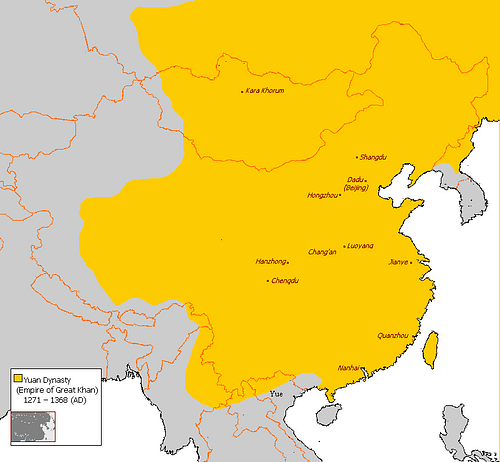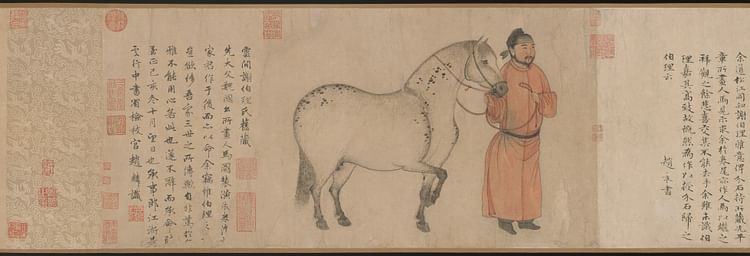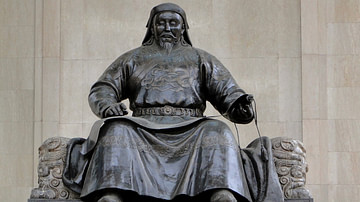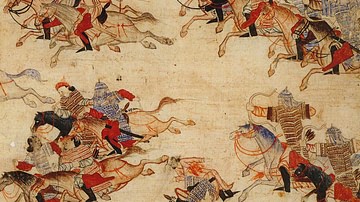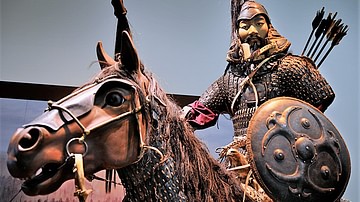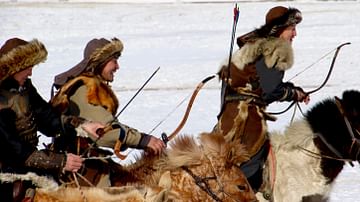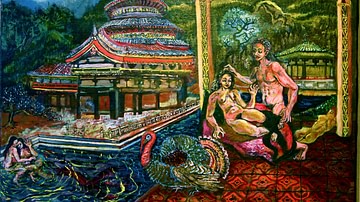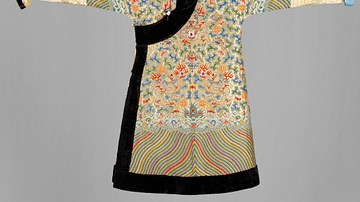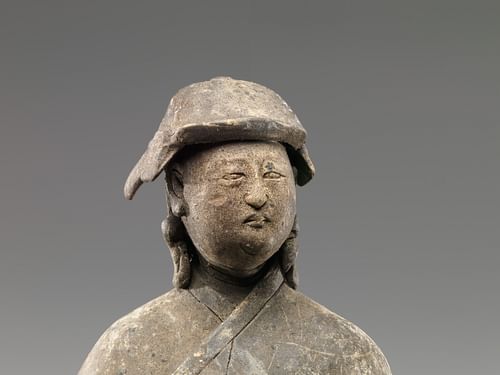
The Yuan Dynasty was established by the Mongols and ruled China from 1271 to 1368 CE. Their first emperor was Kublai Khan (r. 1260-1279 CE) who finally defeated the Song Dynasty which had reigned in China since 960 CE. Stability and peace within China brought a certain economic prosperity for some as Kublai and his successors promoted international trade which saw the now-unified country open up to the wider world. While there was peace in the western part of the Mongol Empire, Kublai launched two unsuccessful invasions of Japan and several others elsewhere in South East Asia. The Mongols' reign in China was finally ended due to a lethal cocktail of endless infighting amongst their leaders, inept and corrupt government which overspent and overtaxed, floods and famines. Peasant uprisings rumbled throughout the 14th century CE until one, led by the Red Turban Movement, toppled the Yuan and brought in a new regime, the Ming Dynasty (1368-1644 CE).
Kublai Khan & the Song
In 1268 CE Kublai Khan focussed on finally knocking out the Song Dynasty and establishing himself, as all nomadic leaders before him had dreamed of, as the emperor of China. The Mongols had already made several major attacks on Song territory, notably during the reigns of Genghis Khan (r. 1206-1227 CE) in 1212-1215 CE and of Mongke Khan (r. 1251-1259 CE) in 1257-1260 CE. Equipped with an army of over 1,000,000 men, a large naval fleet, and immense wealth, Song China would prove a stubborn opponent to the otherwise invincible Mongol military machine. The success of Mongol warfare across Asia had been based on fast cavalry, but the Song countered this by deliberately adopting a strategy of more static warfare and building great fortifications at key cities and river crossings. For this reason, it would take eleven long years for Kublai to pick off his targets one by one and finally batter the Song into submission.
The Mongols were helped by many Song generals defecting or surrendering their armies, and the fact the imperial court was beset by infighting between the child emperor's advisors. Ultimately, the empress dowager and her young son Emperor Gongzong (r. 1274-5 CE) surrendered along with their capital Lin'an on 28 March 1276 CE. The Song royals were taken prisoner to Kublai's new capital at Beijing (Daidu). Groups of loyalists fought on for three more years, installing two more young emperors in the process (Duanzong and Dibing), but the Mongols swept all before them. Finally, on 19 March 1279 CE a great naval battle was won at Yaishan near modern-day Macao; the Mongol conquest of China was complete. It was the first time that country had been unified since the 9th century CE, not that this was much consolation to the countless dead, robbed and displaced across China.
Establishing Government
Making himself emperor of China, Kublai gave himself the reign name Shizu and, in 1271 CE, his new dynasty the name 'Yuan', meaning either 'origin' or 'centre, main pivot.' The start date of the Yuan Dynasty is variously put at 1260 CE (Mongke's campaign), 1271 CE (first official use of the 'Yuan' dynasty title), 1276 CE (death of the last Song emperor and fall of the Song capital) or 1279 CE (final extinguishing of Song resistance).
Beginning with Kublai, Mongol rulers made some superficial attempts to appeal to their new Chinese subjects by adopting such traditions as emperor's robes, travelling in a sedan chair and surrounding themselves with Confucian advisors. The real power, though, remained in Mongol hands as key administrative positions in the newly created 12 semi-autonomous provinces that China and northern Korea (annexed in 1270 CE) was now divided into largely went to Mongols, especially to members of the very large Mongol imperial bodyguard. The traditional six Chinese ministries, in place since the Tang Dynasty (618-907 CE), continued as before, but there were Mongol institutions, too, like the Shumi Yuan or Ministry of War.
Kublai abolished the civil service examinations which would have favoured Chinese officials with their Confucian education (they were reinstated in 1313 CE but Mongols still received advantages). Although many Chinese officials continued to work as before, they were subject to random and secret inspections by Mongol-trusted censors. The Mongol regional official known as the jarquchi was appointed to Chinese territories, and these and representatives of the various Mongol clans made up a local government for each province. The Mongol police force, the tutqaul, was given the task of ensuring roads were kept free from bandits, and western Asians, particularly Muslims, were often given roles in the financial side of government such as finance ministers and tax inspectors.
A New Social Order
Kublai ensured that Mongols always gained an advantage in China by officially classing them as superior in rank to Chinese. The four official Yuan ranks, based on perceived loyalty to the Yuan rulers, were:
- Mongols
- Semu - people from Central Asia and/or speakers of Turkic languages
- Hanren - northern Chinese, Tibetans, Khitans, Jurchen and others
- Nanren - southern Chinese formally ruled by the Song.
Being a member of one of the above four classes had repercussions for an individual's tax status, their treatment by the judicial system and their eligibility for positions in the state administration (there was a 25% capped quota for southern Chinese, for example). Differences in treatment included northern Chinese being taxed by household while southern Chinese had to pay according to the area of land they owned. Punishments were a particularly striking area of difference with, for example, a Mongol found guilty of murder only having to pay a fine while a southern Chinese convicted of mere theft was fined and then tattooed as a criminal. The new law code introduced in 1270 CE, however, had only 135 capital crimes, half of those in the code used by the Song.
There were other measures of segregation, too, such as forbidding Chinese to take Mongol names, wear Mongol clothes or learn the Mongol language. Intermarriage was discouraged. Rather than being a solely racially-motivated policy, though, Kublai and his successors were most concerned with controlling their subjects, making it easier to identify who was who and ensuring there were no rebellions; Chinese were forbidden to carry weapons and congregate in public, for example.
At least traditional religions were permitted to continue as long as they did not threaten the state, although Buddhism was generally favoured over the traditional Chinese Confucianism. The Mongols' own preference for shamanism showed no signs of change, although Kublai himself converted to Tibetan (Lamaist) Buddhism. Further, despite the obvious discrimination, southerners kept their classical Chinese culture very much alive through private meetings and the arts, often producing paintings, poetry and plays which conveyed within them subtle protests against the Yuan regime. The latter art form, which included puppet theatre as well as live actors, boomed under the Yuan because of its visual appeal and striking stories; the Mongols, unable to speak Chinese, had little time for prose and poetry.
Foreign Policy & Trade
Kublai Khan was particularly interested in re-establishing the Chinese tribute system which had been neglected during the latter part of the Song's reign. The system had states pay symbolic and material tribute to China's dominant position as the centre of the known world, the 'Middle Kingdom.' Not only was it a means to further legitimise his position as Chinese emperor but it could also bring in useful material goods and help expand international trade. There was also the matter that Mongol rulers legitimised their position through conquest and the distribution of booty to their followers to ensure loyalty and continued service. Kublai, then, embarked on a series of campaigns to bring China's neighbours back to their former position of subservience to the emperor.
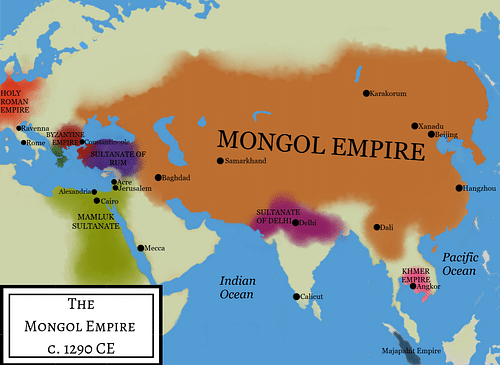
Japan was twice invaded (1274 and 1281 CE), but each time staunch resistance and fortuitous storms, the kamikaze or 'divine winds', forced a retreat. Like Japan, Southeast Asia was attacked in various land and naval campaigns but they also proved an elusive prize with invasions of Vietnam (1281 and 1286 CE), Burma (1277 and 1287 CE), and Java (1292 CE) achieving only limited success but at least gaining regular tribute from the Pagan kingdom in Burma and the Champa and Dai Viet kingdoms of Vietnam. It seemed that conducting naval warfare overseas and the unfamiliar climate of Southeast Asia were insurmountable obstacles to Yuan expansion. Kublai never gave up on Japan, though, and continued to send unsuccessful diplomatic missions to persuade the country to join the Chinese tribute system.
In other parts of Asia, to the west, there was relative peace, the so-called Pax Mongolica, although there was a major rebellion in Tibet in the early 1290s CE, and the other descendants of Genghis Khan, especially the Ogedeids, continued to nibble at China's western borders. Nevertheless, the Mongols as a group, by forging an empire from the Black Sea to the Korean peninsula (even if it was now split into large khanates ruled by Genghis Khan's descendants) had managed to expose China to a wider world. This was especially so in regard to the west with contacts through Persia and, thanks to missionaries, ambassadors, and travellers like Marco Polo (1254-1324 CE), Europe. Between c. 1275 and 1292 CE Marco served Kublai Khan, seemingly in the capacity of a roving ambassador/reporter on the more remote parts of the Mongol Empire. On his return home, Marco wrote of his experiences in his book The Travels of Marco Polo, first circulated c. 1298 CE. His descriptions are amongst our best sources for the Yuan Dynasty and the emperor, in particular.
Of more concrete benefit to the Mongols and Chinese than world fame, the Yuan did promote international trade, too. Artisans and craftworkers were given a more elevated status than previously and given tax exemptions. Merchants, not being producers but 'exchangers,' had been discriminated against under the Song, and these, too, now benefitted from more favourable tax measures, low-cost loans and the end of sumptuary regulations. Merchants were encouraged to use paper money, currency exchanges were better regulated, and more roads, canals (including the Grand Canal connecting southern and northern China), and use of ocean-going ships aided the transport of goods. The effect of these policies was to create a boom in crafts and trade, especially of silk and fine porcelain, the latter product now being supervised by a specific government agency, paving the way for the later Ming potters to gain worldwide fame of their own. Trade also brought a greater exchange of ideas and technologies such as Persian expertise in astronomical observations, maps, luxury textile weaving, and irrigation coming to China, and gunpowder weapons, printing, the mariner's compass, and paper money to the west. Islam also spread further to the east as merchants crisscrossed Asia.
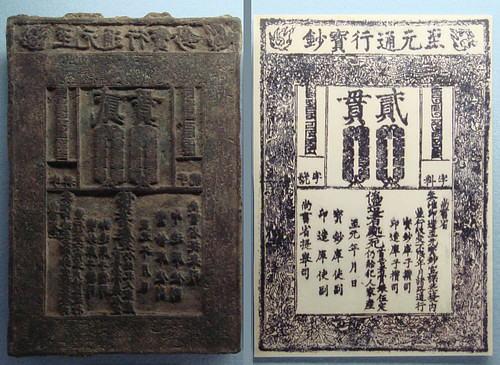
A Long Decline
Kublai was succeeded by his grandson Temur Oljeitu as Khan and emperor of China (r. 1295-1308 CE) who, continuing with the same institutions and many of the same officials appointed by his father, enjoyed a peaceful and successful reign. There then followed a long line of short-reigning rulers who struggled to balance the competing pro-Chinese and pro-Mongol traditionalists that divided the government at all levels. This rivalry sometimes broke out into violence with one emperor being assassinated and another thrown out following a coup. In addition, many southern Chinese, especially the intellectual class, clung on to their traditions, some even refusing to acknowledge the very existence of their Mongol masters and retiring to pursue the arts.
Collapse & Ming Dynasty
By the mid-14th century CE, the Yuan rulers had been beset by a devastating combination of unusually cold winters, famines, plagues, and flooding of the Yellow River which all combined to bring hyper-inflation when the government tried to solve the problems of a damaged infrastructure by printing too much paper money. There followed widespread banditry and uprisings by an overtaxed peasantry. Worse, some of the local elites and provincial administrators in southern China were colluding with the bandits, smugglers and even religious leaders to take over entire towns. Yuan China was disintegrating from within.
The Yuan rulers had not helped themselves by squabbling over power, creating an overblown bureaucracy, and wasting revenue and land resources on a few favoured princes and generals. Most importantly of all, they failed to quash numerous rebellions, including that perpetrated by a group known as the Red Turban Movement, an offshoot of the Buddhist White Lotus Movement, led by a peasant called Zhu Yuanzhang (1328-1398 CE). Zhu replaced the Red Turban's traditional policy aim of reinstating the old Song Dynasty with his own personal ambitions to rule and gained wider support by ditching the anti-Confucian policies which had alienated the Chinese educated classes. Alone amongst the many rebel leaders of the period, Zhu understood that to establish a stable government he needed administrators not just warriors out for loot.
Zhu Yuanzhang's first major coup had been the capture of Nanjing in 1356 CE. Zhu's successes continued, and he defeated his two main rival rebel leaders and their armies, first Chen Youliang at the battle of Poyang Lake (1363 CE) and then Zhang Shicheng in 1367 CE. Zhu was left the most powerful leader in China, and, after taking Beijing, the last Yuan emperor of a unified China, Toghon Temur (r. 1333-1368 CE), fled to Mongolia and the old, now largely abandoned capital Karakorum. The Yuan would, thus, continue to rule in Mongolia under the new name of the Northern Yuan Dynasty (1368-1635 CE). Meanwhile, Zhu declared himself the ruler of China in January 1368 CE. Zhu would take the reign name of Hongwu Emperor (meaning 'abundantly marital') and the dynasty he founded Ming (meaning 'bright' or 'light').
